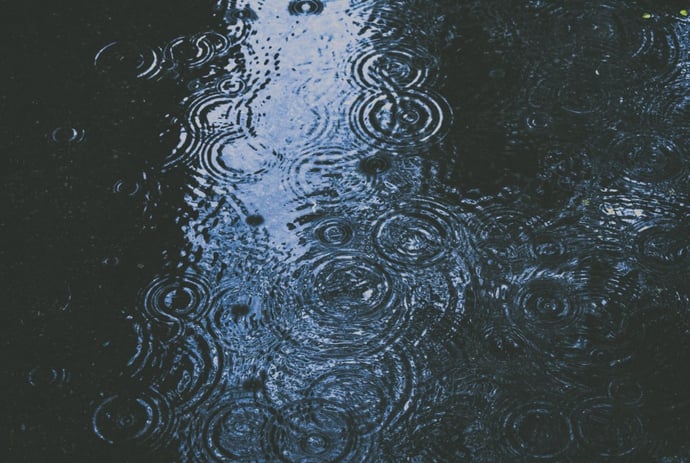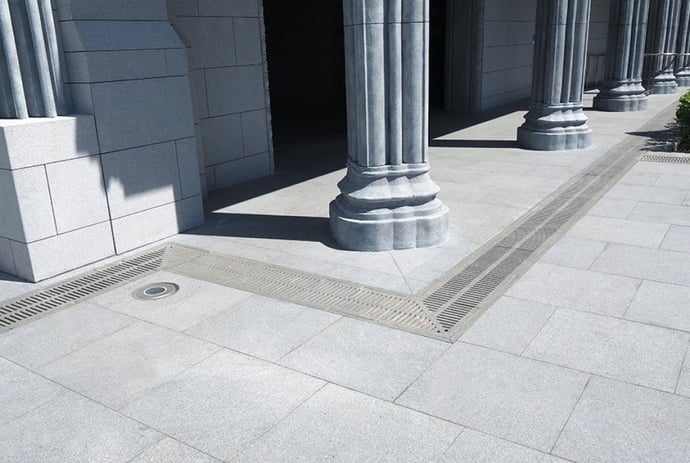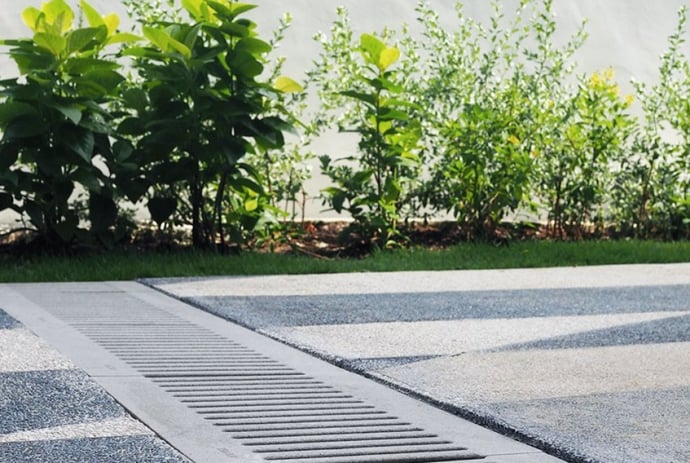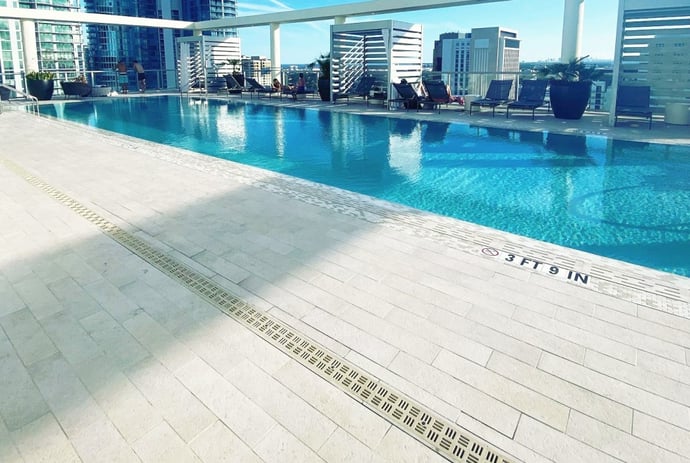Excess water in a landscape may seem harmless but can be a major issue.
It is unsightly and can lead to pooled water, bad odours, and even mosquitos in the landscape. It can even go further and cause more severe issues such as damage to structures and landscape, and even erosion. Damage to a landscape can cause a loss of appeal, thus requiring expensive repairs.
Drainage systems can be installed to quickly remove surface water from an area to combat this issue. A trench drain system is one of the more common and efficient options to choose from.
What Is a Trench Drain System?
A trench drain system is a linear surface drainage system with the aim of removing excess water from the surface of an area. The system is made of long drain channels that funnel the water away. These channels are then covered with trench grates that can come in different styles and materials.

Excess surface water can cause a long list of problems. Luckily, trench drain systems can remove it quickly. ©Alex Dukhanov | http://www.unsplash.com/
The Different Types of Trench Drains
Trench drains can be broken down into three main types based on how they are formed: pre-cast, cast in place, and linear drain systems. While each has its own benefits and downsides, generally, they are durable and reliable, with a long lifespan.
Rather than being fabricated on-site, pre-cast trench drains are manufactured in a factory. Metal moulds with premeasured dimensions are used to form the trenches out of concrete. Then, the drains are transported to the site where they are installed.
The fact that the trench is formed in a factory offers some benefits. Climate-controlled conditions ensure the trenches have the ideal temperature and humidity as well as plenty of time to cure. This helps form a very strong channel. It also means that they can easily be done while the trench is created if one wants special additions. Some people use this benefit to have their trenches dyed a different color.
However, pre-cast trench drains has some downsides. The drain channels are usually quite large, adding transportation costs since concrete can be expensive to move. In addition, pre-cast drains typically need to include joints in the drain in order to bring them down to a transportable size.
 Three main trench drain systems are available and can be chosen based on the application’s needs.
Three main trench drain systems are available and can be chosen based on the application’s needs.
Cast-in-place trench drains are formed on-site, though they are still made of concrete. A channel is dug, and a form is created with reinforcing bars. Concrete is poured, and the forms are removed once the concrete is dry.
Since they are created onsite, cast-in-place drains are very accurate in their dimensions. They also don’t need to include joints, add high transportation costs, or use machinery for installation. However, there is not much of an option for special requests or changes when creating the drain. In addition, the weather determines when the channel is poured. Temperature, precipitation, and humidity can all affect the curing process.
Linear drain systems are similar to pre-cast trench drains, although they are more modern. Based on how they are created, they have a mix of the pros and cons of both cast-in-place and pre-cast trench drains.
They are narrow and use lighter materials, such as fiberglass, plastic, steel, or polymer concrete. A trench is dug, and the materials are used to form a channel and grate. Afterwards, concrete is poured around the drain to add extra structural support.
The Role of the Grate
While a trench grate may appear to serve a merely decorative purpose, it has a valuable role within the trench drain system. The grate helps block large debris from entering the channel. This means the drain won’t get clogged and prevent water from being drained away.
 Trench grates allow traffic to move over the channel while keeping debris out of the trench.
Trench grates allow traffic to move over the channel while keeping debris out of the trench.
The grate also makes travel over the drain easier. Without it, the channel would leave a wide trench that could prevent travel or make it difficult for pedestrians, bicycles, and vehicles. The grate provides a surface that one can cross over.
Because of these purposes, it’s essential to choose a grate that fully meets the application. It needs to have the appropriate load rating to withstand traffic. Depending on placement, it may also need to include safety and other features, such as ADA compliance.
A trench grate should be made of a durable material, such as Jonite’s reinforced stone, which prevents corrosion and makes maintenance much more manageable. Many also choose to spruce up the grate by choosing customized colors and styles.
Benefits of Trench Drain Systems
The benefits of a trench drain system stem from the ease and speed with which the system removes excess water. It does this quickly enough that the water does not have time to become a safety hazard or cause damage.
Without an adequate drainage system, excess water can damage the foundation of buildings or cause cracks in a driveway or other hardscaped areas. A trench drain system can even help protect plants by diverting water that would otherwise flood them.
 A trench drain system can help keep hardscape areas dry and usable.
A trench drain system can help keep hardscape areas dry and usable.
Trench drain systems also help to increase the usability of an area. Pathways and patios can become unusable and unsafe if they are left covered with surface water. A drain helps remove water, keeping the surface from becoming slick and allowing it to dry quickly.
Choose the Best Trench Drain System
A trench drain system provides an efficient way to remove excess water from almost any area. When combined with a good trench drain grate, they are a great way to make areas more usable while preventing damage to other structures. Jonite’s reinforced trench drain grates can create an efficient trench drain system for your landscape.










